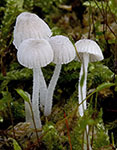Growing singly or gregarious on moss-covered bark of different deciduous trees. Autumn to early winter. Scattered in southern and western part of the area, including the UK. Recorded in Denmark (Læssøe 2019). Not yet found in Norway.
Pileus 2-6 mm across, hemispherical, conical, campanulate to more or less convex, sulcate, translucently striate, white-furfuraceous to white-farinose, with fimbrate margin. Lamellae 7-14 reaching the stipe, ascending, broadly adnate, decurrent with a tooth, white with concolorous edge. Odour and taste not noticed. Stipe 5-18 x 0.1-1 mm, cylindrical, curved to somewhat flexuous, somewhat widened at the base, but not springing from a basal disc, white-puberulous above, densely white-furfuraceous below, watery white greyish white.
Basidia 17-28 x 9-13 µm, clavate, 4-spored with sterigmata up to 4 µm long. Spores 6-10 x 6-8 µm, Qav = 1.1-1.2, globose to subglobose, smooth, amyloid. Cheilocystidia 15-40 x 7-25 µm, clavate, apically covered with numerous, short, cylindrical excrescences up to 1.5 µm long. Pleurocystidia absent. Lamellar trama dextrinoid. Hyphae of the pileipellis 2-7 µm wide, non-gelatinous, smooth to diverticulate, terminal cells 16-60 x 9-27 µm, acanthocysts, broadly clavate, obpyriform to globose, with numerous and moderately large or fewer but very large, spiny excrescences 0.5-5.5 µm long. Hyphae of the cortical layer of the stipe 2-4.5 µm wide, non-gelatinous, smooth, caulocystidia abundant, 15-70(-210) x 6-28 µm, obpyriform to clavate, or long and cylindrical (the long ones especially at the base of the stipe), densely covered with cylindrical excrescences, some thorn-like, up to 8 µm long. Clamp connections rare, but present on basidia, cheilocystidia and rarely on pileipellis elements.
The macroscopic description has been taken from Maas Geesteranus (1983) and complemented with observations by Robich (2003) and Desjardin (1995). The microscopic details are based on examination of a Belgian collection (leg. L. Vannieuwerburgh). I have not seen this species in nature.
Maas Geesteranus (1983) placed the new taxon in sect. Saccharifereae Kühner ex Singer. Distinctive features of M. corynephora are a white furfuraceous to farinose pileus up to 6 mm wide, adnate lamellae, a short, white, furfuraceous stipe lacking a basal bulb or basal disc, large subglobose spores, 4-spored basidia, clamp connections and densely spinulose caulocystidia.
It is distinguished from the other European species in the section on account of the absence of a basal disc, subglobose spores and large, obpyriform, clavate or cylindrical caulocystidia.

Next image
Microphotos of the cheilocystidia
Microphotos of the hyphae of the pileipellis with terminal cells
Microphotos of the terminal cells of pileipellis
Microphotos of the spores
Microphotos of the caulocystidia
Microphotos of cylindrical caulocystidia
Further images on the web:
Gruppo di Muggia e del Carso (with excellent microphotos!)
Enzo Musumeci (also with excellent microphotos!)
|